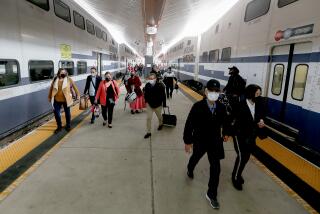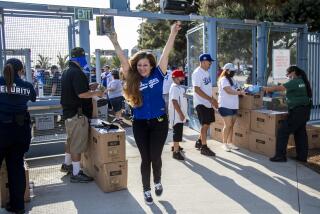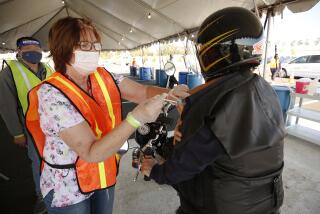58 new deaths in L.A. County as California communities debate how to lift virus restrictions

- Share via
With Gov. Gavin Newsom announcing that some stores could open by the end of the week, Southern California communities are considering what to do next as coronavirus cases continue to increase.
Los Angeles County officials confirmed 58 more COVID-19 deaths Tuesday, bringing the total number of coronavirus-related fatalities in the county to 1,313. Of those who have died, 647 were living in institutional settings — the majority of which were nursing facilities.
Officials reported an additional 1,638 cases — a high number that is largely due to a backlog in data reporting. So far, there have been 27,815 confirmed coronavirus infections in the county.
As communities continue to report more cases and deaths linked to the virus throughout the state, which has seen more than 56,000 confirmed infections and nearly 3,000 related deaths, Newsom announced Monday that some retail stores across the state could reopen with modifications as early as Friday. The news came amid growing pressure to ease the stay-at-home order that has cratered the California economy.
On Tuesday, Newsom said social-distancing practices would remain in place as more people would be put at risk when restrictions were lifted.
“We have to maintain the core construct of our stay-at-home orders,” he said at a news conference.
The economy will start to reopen, but that doesn’t mean people can “go back to normal,” Newsom said. Since COVID-19 is still present, the reopening relies on Californians remaining cautious and following safety protocols.
The virus has affected some parts of California more than others, and some cities’ officials have struggled with when, how — and whether — to begin reopening. Ventura County, for example, has been less affected than has neighboring Los Angeles County, the most populous in the state with 10 million people. L.A. County continues to be a hotbed of the crisis.
Here is a rundown of where Southern California stands right now:
Los Angeles County
Los Angeles Mayor Eric Garcetti said Monday that different cities would need to take different steps to emerge from the pandemic-induced shutdown and that city and county officials were still trying to determine the safest course.
“Our timing on opening may vary from other parts of the state,” he said. “I will reopen our city with careful consideration, guided by public health professionals.”
Garcetti said he did not expect city businesses to be able to offer curbside delivery on Friday in step with Newsom’s outline. L.A.’s Safer at Home order is in effect until May 15 and Garcetti said that he hoped steps restricting commerce could begin to be rolled back by then.
On Tuesday, Garcetti said he supports working in the next few days and weeks on the reopening of “low-risk spaces,” such as trails.
He also announced a new initiative, L.A. Represents, to provide free legal services to residents facing hardships, such as debt and bankruptcy, caused by COVID-19. Volunteer attorneys would represent vulnerable renters and survivors of domestic violence, he said.
“People are finding themselves in some of the most pressing and painful moments of their lives,” Garcetti said. “These are complex situations, and we don’t always all understand the law.”
He said the initiative would also include a support system for small businesses to get back on their feet by helping them renegotiate leases or apply for government loans.
“Small businesses are the backbone of our economy,” he said. “They too often lack effective representation.”
Garcetti also said he is permitting flower wholesalers to open to gear up for Mother’s Day, which he described as one of the industry’s biggest days of the year.
Los Angeles County Public Health director Barbara Ferrer said Monday that officials would be publicly sharing recovery plans this week, noting that “wherever it’s possible to safely reopen, we’ll be doing so as quickly as possible.”
She noted that although social distancing practices had helped slow the spread of COVID-19, the virus remains easily transmissible.
“The virus has not changed,” she said. “More people die in L.A. County every day from COVID-19 than any other disease.”
On Tuesday, she reiterated that fact, adding that as the county plans its first stages of reopening, it must ensure that a spike in cases does not take place.
“We want to make sure we don’t see an increase in our death rate as we are reopening,” she said.
Ferrer previously said the total number of deaths linked to the coronavirus was greater than those who died from influenza over the last eight-month flu season.
Of the 1,201 individuals who have died of COVID-19 where race and ethnicity have been identified, 38% of individuals were Latino, 28% were white, 19% were Asian, 12% were African American, 1% were Native Hawaiian/Pacific Islander, and 1% identified as another race.
Ferrer said African Americans and those who were identified as Native Native Hawaiian/Pacific Islander were dying at a much higher rate than all others in L.A. County.
Roughly 93% of all individuals who have died from the virus had underlying health conditions, including lung issues, asthma, heart conditions, immuno-compromised illnesses, obesity, diabetes, kidney disease and liver disease. Ferrer stressed that any individuals with HIV also should take steps to protect themselves.
San Diego County
San Diego city and county leaders unveiled proposed regulations that businesses would have to meet before reopening their doors, as well as a plan to help meet those regulations. The county of roughly 3.4 million has reported more than 4,000 infections and at least 144 deaths linked to the virus.
Although a list detailing which businesses will be allowed to reopen is not yet available, city and county leaders have said there are steps all businesses should be taking as they move toward reopening.
“We can’t do anything about the stay-at-home order — that is clearly up to the governor,” county Supervisor Greg Cox said. “But what we can do is help make it easier for businesses to reopen safely and smartly and smoothly as soon as possible if they have these [guidelines] to work from.”
At Tuesday’s Board of Supervisors meeting, Cox and fellow Supervisor Nathan Fletcher will propose the Reopen San Diego Business Safety Framework, which will require all businesses to develop a Safe Reopening Plan before welcoming customers again.
Such reopening plans are intended to ensure employee and customer safety by increasing sanitation, enforcing physical distancing and encouraging communication with county officials.
A plan unveiled Monday is designed to help businesses meet those county regulations. That plan was developed by the Responsible COVID-19 Economic Reopening Advisory Group and can be used by restaurants, hair and nail salons, and other businesses as they plan to reopen.
“San Diego is ready to recover, and is preparing for a reopening that’s safe, strategic and specific to our diverse industries,” San Diego Mayor Kevin Faulconer said. “These guidelines will help get the economy back on its feet and get San Diegans back to work when state and regional orders are lifted.”
The advisory group’s plan includes five focus areas:
- Employee health: Procure and provide personal protective equipment for employees, and commit to voluntary compliance with public health officials on contact tracing and testing.
- Safe work site entry: Establish controlled entrance and exit practices to avoid queuing issues and work with the Public Health Department to create processes for checking employees’ symptoms.
- Workplace distancing and conditions: Evaluate occupancy and capacity to ensure proper physical distancing and keep shifts consistent with the same employees in each rotation or shift.
- Employee training and compliance: Ensure signage on safety requirements, such as hand-washing, physical distancing and reporting procedures for employees who become ill.
- Enhanced cleaning and sanitation: Develop a sanitation plan that includes frequent cleaning of restrooms, workstations and public spaces.
The economic advisory group also plans to provide enhanced guidance specific to industries such as restaurants, spas and construction. Those plans are still in development.
Riverside County
The Riverside County Board of Supervisors is also considering ending local public health orders amid a growing push to begin reopening. The county of roughly 2.5 million has reported more than 4,300 infections — the second highest in the state — and 181 deaths linked to the virus.
Supervisors Karen Spiegel and V. Manuel Perez proposed the changes, which include rescinding school closures, ending limitations on short-term lodging, removing restrictions on golf course use and eliminating the requirements to wear face coverings and engaging in social distancing.
The Riverside City Council on Monday urged the county to hold off on the plan.
“We know that the coronavirus is still out there and that we need to continue to be vigilant,” said City Councilman Andy Melendrez, according to the Riverside Press-Enterprise.
Last week, the county’s public health officer, Dr. Cameron Kaiser, lifted a few restrictions, including reopening some parks, trails and recreation areas, such as golf courses and tennis courts. However, Kaiser also extended a county health order requiring residents to wear face coverings and practice social distancing through June 19.
Individual counties have the authority to impose health orders that best suit their region, as long as they are not more lax than Gov. Gavin Newsom’s stay-at-home order. Riverside County had previously implemented some of the strictest public health orders in California.
“I want to thank our residents and our county team, whose actions to this unprecedented pandemic have helped us get to this point,” Perez said in a written statement. “Now, we must continue to prepare for our economic recovery and get people back to work.”
Orange County
Orange County officials continue to express concern over Newsom’s decision to close beaches to slow the spread of coronavirus, even as the county continues to report new cases and deaths.
The county of roughly 3.2 million has confirmed nearly 90 infections and 57 deaths, including five reported Monday.
After Huntington Beach and Dana Point filed a lawsuit against the decision, and Newport Beach agreed to file a court brief in support of the endeavor, state officials announced Tuesday that the beach cities would be permitted to reopen their stretches of coastline this week with certain limitations.
The announcement came one day after officials said Laguna Beach and San Clemente would be allowed to open their shores this week, with similar limitations in place.
Both cities previously submitted plans to the state that would allow active recreation along their coastlines while maintaining measures to avoid overcrowding and allow for appropriate physical distancing.
“We appreciate the governor’s willingness to work with us to provide a responsible, gradual approach to reopening all beaches in Laguna Beach for active recreation,” Mayor Bob Whalen said in a statement Monday. “This will allow people the opportunity to walk, jog, swim and surf and get some fresh air and exercise on a limited basis, but not congregate or gather in large groups.”
Wagner, however, characterized the idea of an active plan as “half-steps that satisfy, I guess, the governor’s need to feel like he’s won something.”
“The science is entirely in favor of the position the county took before the governor’s ill-advised order,” he said.
Orange County Executive Officer Frank Kim said Monday that the decision of whether the county itself should submit such a plan rested with the Board of Supervisors, which is expected to discuss the matter Tuesday.
More to Read
Sign up for Essential California
The most important California stories and recommendations in your inbox every morning.
You may occasionally receive promotional content from the Los Angeles Times.














